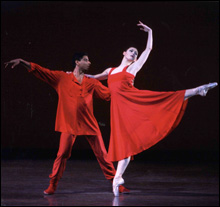
RUSSIAN SEASONS: Ratmansky creates a community through a constantly modulating stream of dancing.
|
NEW YORK — When you hear of a new ballet titled Russian Seasons, you visualize khovorods and trepaks danced in a simulated birch grove by peasants in earth-toned costumes. Fortunately, expectations of banality can always be thwarted. Alexei Ratmansky’s contribution to New York City Ballet’s showcase of new choreography, the Diamond Project, both utilized and overturned the stereotypes. The ballet premiered last Thursday night and can be seen once more, on June 21, before the company ends its spring season at the New York State Theatre.
Not yet 40, Ratmansky is the artistic director of the Bolshoi Ballet and has an impressive record as a choreographer that includes a prize-winning Anna Karenina for the Royal Danish Ballet, Le Carnaval des Animaux for San Francisco Ballet, and The Bright Stream, which was shown in the US two years ago by the Bolshoi.
Russian Seasons has a fascinating score based on folk songs and set for strings, solo violin (Arturo Delmoni), and mezzo-soprano (Susana Poretsky) by the contemporary Ukrainian composer Leonid Desyatnikov. The music suggests the Stravinsky of Les Noces at times and the earlier Stravinsky of Petrushka at others. It can be more modern and dissonant, then even postmodern. The 12 dancers — principals, soloists, and corps members — are grouped together quite democratically, but they all dance like stars.
What I noticed first, after getting over the initial shock of the streamlined folkish costumes in pop-art colors, was how the movement is classical to the core. Without fudging the line, elevation, speed, “character” displacements of the upper body, articulation and mobility in the legs and feet — classical ballet’s arsenal of technical resources — Ratmansky combines steps in new ways, gives his charged virtuosity spaces to breathe, and creates a community through a constantly modulating stream of dancing.
You seldom see everyone dancing together. Instead the dancers come and go in small, variable units throughout the music’s 12 sections. Sometimes these subgroups dance for themselves, rejoicing in their own physicality. They team up with partners for fast, airy duets. Sometimes they play games, not always cheerful ones; sometimes they seem to be going through some sort of ritual observance. Solo figures dance more individual feelings; the groups surround them, support them, offer comfort.
Notes provided to the press explained the musical structure as a progression through the seasonal and liturgical calendar. We also got translations of the five sung texts full of an intense love of the real world and shadowed with thoughts of death. The ballet reflected this cycle without literally describing any of it, but I wondered why the company denied the audience this other level of poetry.
If there was any narrative thread, I thought it was carried by the solo dancers. As the ballet went on, the somber thoughts seemed to overtake the happy ones. Albert Evans emerged from leading the men’s group to serving as a father figure or priestly guide. Wendy Whelan, Sofiane Sylve, and Jennifer Ringer danced alone at different times, each shaken by some inner disturbance: Whelan by sorrow, Sylve by wildness, Ringer by mischief. Ringer seemed to become a kind of evil idea that pursued and perhaps possessed Sylve. Whelan picked imaginary flowers desolately, as the others tied to console her and then passed by. The singer tells how her lover hasn’t returned from the war.
After many encounters and dance inventions, Whelan is led off by Evans, both of them now in transfiguring white versions of the same costumes. The others embrace their partners and slowly lie down. Poretsky sings: “We need nothing,/Only six feet of earth/And four boards./Alleluia, Alleluia.”
Russian Seasons suggests Les Noces, Bronislava Nijinska’s austere invocation of community. But like two great George Balanchine works I revisited over the weekend, Divertimento No. 15 and Donizetti Variations, it also takes you on an absorbing journey into the pleasures of dancing itself.